Woodyard D. (ed.) Pounders Marine diesel engines and Gas Turbines
Подождите немного. Документ загружается.

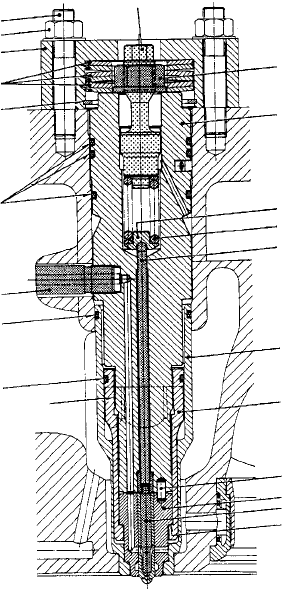
660 Sulzer (Wärtsilä)
A VIT system was standard for ZA40S engines not equipped with a charge
air waste gate (see below). The helix of the pump plunger is shaped so as to
raise P
max
throughout the part-load range and thereby reduce part-load brake
specific fuel consumption.
The single-pipe exhaust system serving the ZA40S engine yields a reason-
able combination of the advantages of the pulse system (partially retaining the
kinetic energy of the exhaust gases) with the simplicity of a constant pressure
system. This had been recognized in the 1950s but could only be realized when
modern high-efficiency turbocharger types became available. Turbocharger
matching, however, can be demanding with the short valve overlap necessary
for low fuel consumption at full load; it may lead to surging at part loads and,
furthermore, a high-efficiency turbocharger shows a pronounced decrease in
charge air pressure at part load.
These difficulties were overcome in the ZA40S by using charge air bypasses
and charge air waste gates to create load-adaptable supercharging systems that
often enable the engines to surpass the performance of conventional super-
charging systems (Figure 26.15). The ZA40S system, Sulzer asserted, could be
tailored to give low fuel consumption through the normal engine load range but
1
2
3
4
5
6
7
8
9
10
11
Molykote-G
20
19
18
17
16
15
14
13
12
Molykote-G
FIgure 26.13 ZA40S engine fuel injection valve
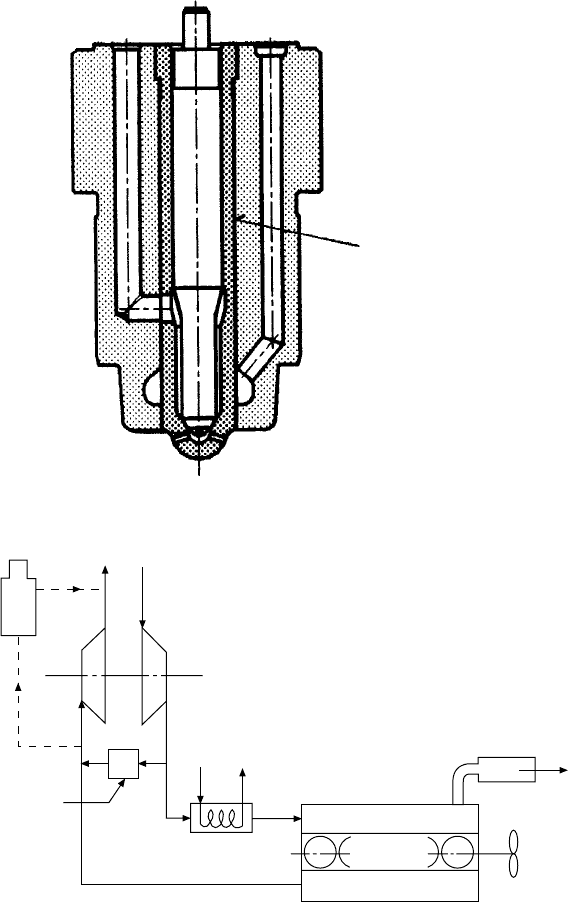
also adapted to yield the high torque required at part load in the propulsion of
icebreakers and short sea shuttle ferries. Progressively opened above about 85
per cent load, the optional waste gate valve allows higher boost pressures to be
used at part load for a substantial improvement of part-load brake specific fuel
consumption while avoiding excessive cylinder pressures at higher loads.
ZA40 and ZA40S engines 661
Shrink fitted
FIgure 26.14 ZA40S engine fuel injection nozzle
Exhaust
waste
gate
Turbine
Compressor
Charge air cooler
Air receiver
Engine
Exhaust gas receiver
Charge air waste gate
Charge air
bypass
FIgure 26.15 ZA40S engine turbocharging system with charge air bypass and
waste gate
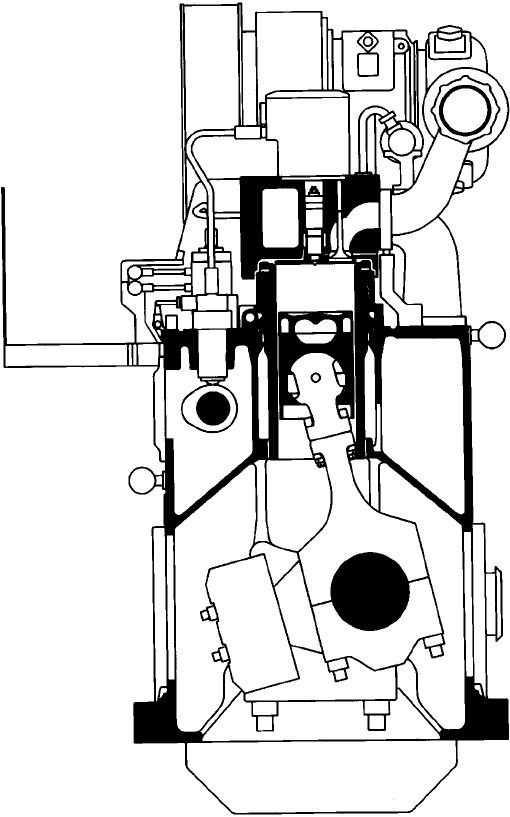
662 Sulzer (Wärtsilä)
ZA50S engIne
Rising demand for compact, high-output medium-speed diesel propulsion
installations—particularly from cruise and ferry sectors—stimulated Sulzer to
introduce in 1995 a larger bore derivative to complement the successful ZA40S
engine. This 500 mm bore/660 mm stroke ZA50S design extended the power
range of the programme to 21 600 kW at 450 rev/min from six-, eight- and nine-
in-line and V12-, 14-, 16- and 18-cylinder models (Figures 26.16 and 26.17).
FIgure 26.16 Cross-section of ZA50S engine
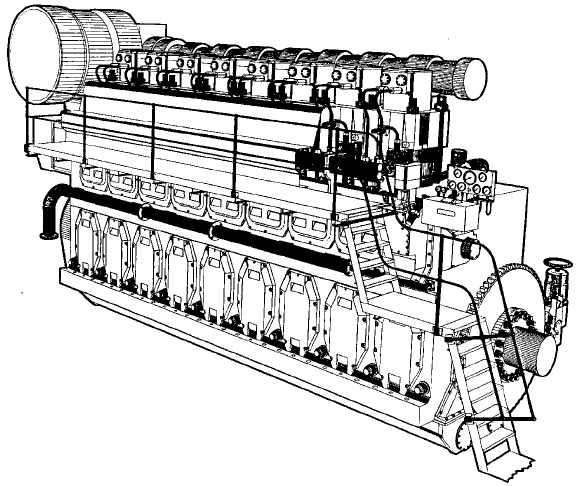
The ZA50S engine was subsequently dropped from the programme, its output
range covered by the Wärtsilä 46 design.
A shorter and lighter engine than rivals in the same power class was sought
by the ZA50S designers, and attention was paid to reducing the engineroom
headroom requirement and the minimum distance necessary between engines
in multi-engine plants. The connecting rod design contributed to a particularly
low dismantling height.
The ZA50S engine inherited the main features of the ZA40S, notably the
rotating piston, fully bore-cooled combustion space, high stroke–bore ratio,
cylinder head without valve cages and load-adaptable turbocharging with sin-
gle-pipe exhaust system. The opportunity to innovate was taken, however, by
adopting hydraulic actuation for the gas exchange valves, standard for many
years in low speed two-stroke engine practice but introduced here for the first
time to a medium-speed four-stroke design (Figure 26.18).
Hydraulic actuation—in conjunction with pneumatically controlled load-
dependent timing to provide variable inlet closing—yielded flexibility in valve
timing, fostering lower exhaust gas emissions and improved fuel economy.
Variable inlet closing, together with optimized supercharging, delivered a very
flat fuel consumption characteristic across the whole load range of the engine. A
considerable reduction in smoke levels in part-load operation was also secured.
A high stroke–bore ratio, similar to that of the ZA40S engine, underwrote
a compression ratio promoting clean and efficient combustion over the whole
ZA50S engine 663
FIgure 26.17 eight-cylinder ZA50S engine
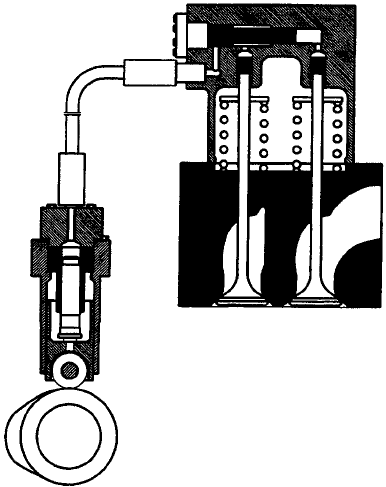
664 Sulzer (Wärtsilä)
engine load range. The combustion chamber is nevertheless sufficiently deep
for the clean combustion of heavy fuel, with low smoke emissions and low
thermal loadings of the surrounding components. The standard ZA50S engine
meets the nitrogen oxide emission limits set by the IMO; further reductions are
possible by engine tuning refinements.
The designer reported that a robust engine block with underslung crank-
shaft combined maximum rigidity with low stresses. The spheroidal cast iron
block was designed for direct installation on resilient mountings. The main
and bottom end bearings follow experience with the ZA40S engine, featuring
bimetal aluminium/tin-alloy running surfaces on thin-walled shell bearings.
The bimetal-type bearings, which have demonstrated fatigue resistance and a
long life expectancy, also exhibit high resistance against wear and corrosion,
together with good embeddability and emergency running behaviour.
The symmetrical design of the rotating piston achieves even distributions
of thermal load and wear around the piston. The piston comprises a steel crown
and spheroidal graphite cast iron skirt. The crown is bore cooled with oil jet-
shaker cooling; and the skirt is provided with inner lubrication, whereby lube
oil is fed to the cylinder liner outwards from within the piston. Effective lubri-
cation of the liner, rings and pistons, with low lube oil consumption, is reported
from ZA40S installations. Full bore cooling of the combustion chamber—the
FIgure 26.18 Hydraulic exhaust and inlet valve drive for the Sulzer ZA50S engine.
the merits cited include: constant valve timing for the exhaust valves; variable valve
timing for the inlet valves (improving fuel economy, emissions and part-load opera-
tion); no valve clearance adjustment; and low noise operation

cylinder head, liner and piston crown—fosters optimum temperatures and tem-
perature distribution, low mechanical stresses and low thermal strains.
The ZA50S engine inherited the proven exhaust valve concept of ear-
lier Z-type engines, based on water-cooled seat inserts, Nimonic valves and
mechanical rotators but no valve cages. The inlet valves also feature mechani-
cal rotators. The times between valve overhauls are arranged to coincide with
those for the pistons.
A key contribution to economy and performance derives from another fea-
ture shared with the ZA40S engine: optimized supercharging incorporating a
simplified single-pipe exhaust system. Appropriate use is made of waste gates
and charge air bypasses to suit the individual application. The reported benefits
are realized in low fuel consumption at both full and part loads, improved load
acceleration behaviour and reduced thermal loading of engine components.
Main parameters of ZA40S and ZA50S engines
ZA40S ZA50S
Bore, mm 400 500
Stroke, mm 560 660
Speed, rev/min 510 450
Mean eective pressure, bar 25.1 24.7
Mean piston speed, m/s 9.5 9.9
Cylinders 6, 8, 9L/12, 14, 16, 18V
output/cylinder, kW 720 1200
Power range, mcr, kW
4500–13 500 7200–21 600
Specic fuel consumption, g/kW h 183–185 181
S20 engIne
Introduced in 1988 for genset drives and small-ship propulsion, the Sulzer S20
engine was distinguished by a significantly higher stroke/bore ratio (1.5:1) than
established contenders in its class (typically with ratios between 1 and 1.2).
The 200 mm bore/300 mm stroke design was available in four-, six-, eight- and
nine-cylinder in-line versions with a maximum rating of 160 kW/cylinder at
1000 rev/min on marine diesel oil or heavy fuel oil. A power band from 460 kW
to 1440 kW was covered over a speed range from 720 rev/min to 1000 rev/min.
Engines for genset duty (designated S20U) were offered with a higher rating to
cover power demands up to 1575 kW at 1000 rev/min (Figure 26.19). The S20
engine was displaced from the joint programme when Wärtsilä acquired New
Sulzer Diesel in favour of the Wärtsilä 20 series.
S20 engine 665
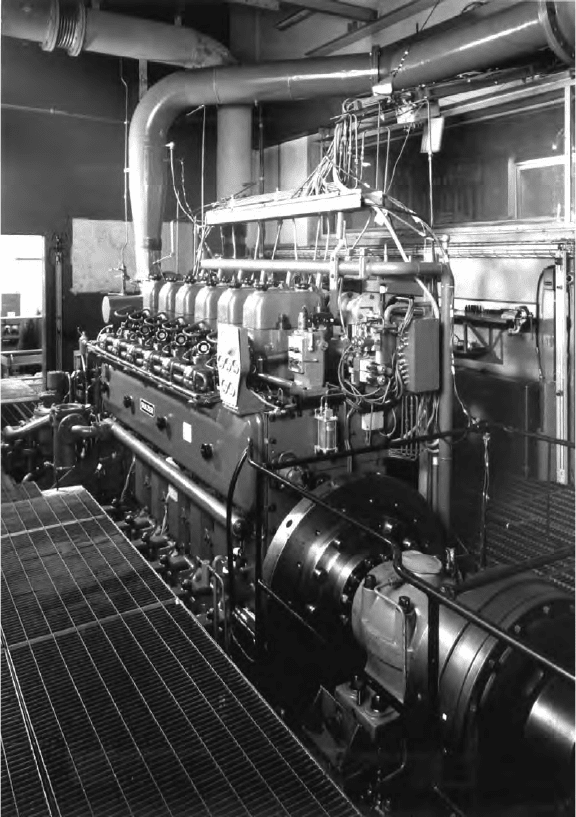
666 Sulzer (Wärtsilä)
The high stroke/bore ratio of the S20 engine allowed a greater compression
ratio while keeping the combustion space high enough to foster an undisturbed
fuel spray pattern for clean combustion. The height of the combustion space
also gave freedom in the choice of valve timing. A high compression ratio fur-
ther yields the high temperatures at the end of compression that are necessary
for quick ignition and clean combustion of heavy fuel oils, especially at low
loads. A pier-to-pier capability burning 700 cSt fuels is claimed, allowing aux-
iliary engines to operate in uni-fuel installations.
FIgure 26.19 Sulzer 6S20 engine
The S20 has almost the same overall dimensions as its predecessor, the
A20 engine, the height being uncompromised, thanks to a short connecting
rod design. The engine block combines crankcase and cylinder housing in one
rigid casting with an integral camshaft housing and charge air manifold. The
main bearing caps of the underslung crankshaft are secured by hydraulically
tightened studs both vertically and horizontally to increase the structural stiff-
ness of the block. Large crankcase doors on both sides of the engine offer good
access for maintenance. As far as possible, lubricating oil and cooling water
are distributed through drillings in the block to reduce pipework. A deep sump
provides a large oil capacity to reduce ageing of the lubricating oil and extend
intervals between oil changes.
The underslung crankshaft is a single-piece forging, machined all over,
with large-diameter crankpins and journals, and fully balanced with bolted-on
counterweights at each crank throw. Both main and big end bearings have thin-
walled aluminium/tin shells, a type which has demonstrated excellent running
and wear behaviour and has become standard for Sulzer’s four-stroke engines.
Provision is made at the free end of the crankshaft for a gear drive for pumps
and a shaft extension for power take-off drive.
High-tensile forged steel connecting rods have a diagonally split big end
with a serrated joint and hydraulically tightened studs. The rod is drilled longi-
tudinally to convey lubricating oil to the gudgeon pin bearing and piston.
A two-part piston—comprising bore-cooled steel crown and lightweight
nodular iron skirt—was specified for maximum reliability in heavy fuel serv-
ice. The corrosion-resistant steel crown addresses the high combustion pres-
sures and surface temperatures associated with heavy fuel operation; and the
cast iron skirt allows smaller running clearances at every load compared with
aluminium skirts. This enables the lateral thrust of the short connecting rod to
be distributed evenly over the full depth of the skirt. Better lubrication condi-
tions are also fostered over the entire power/speed range. Three piston rings
and a scraper ring are specified.
The cylinder liners are centrifugally cast from iron whose composition and
structure were specially developed to yield high mechanical and fatigue resist-
ance as well as good corrosion and wear resistance. The wall temperatures
obtained prevent low-temperature corrosion and minimize abrasive wear.
Individual cylinder heads, incorporating a thick bore-cooled flame plate,
are held down by four hydraulically tightened studs. Each head accommodates
a central fuel injector, two inlet valves, two exhaust valves, a starting air valve
and an indicator cock. The exhaust valves and their housings were designed to
achieve high reliability and durability in heavy fuel operation, the specification
calling for:
l Nimonic alloy valves with a high corrosion and heat resistance.
l Intensively cooled valve seat inserts in the cylinder head to allow
efficient cooling with even temperature distribution around the
valve seat.
S20 engine 667
668 Sulzer (Wärtsilä)
l Valve rotators.
l A cylinder head flame plate which is particularly rigid and bore cooled
for minimum deformation under severe load conditions.
A helix-controlled fuel injection pump for each cylinder has a lubricating
oil barrier on the plunger to prevent fuel oil dilution of the system oil. The
regulating linkage for the pumps is inside the camshaft housing. The nozzles
of the fuel injection valves are cooled by lubricating oil.
Assembled from individual cylinder segments to facilitate overhaul, the
camshaft is driven from the crankshaft via a train of spur gear wheels.
A forced lubrication system for the engine is based on a deep sump. Before
the engine is started, oil is automatically delivered by a motor-driven pre-
lubrication pump.
Engine-driven pumps are arranged as standard for lubricating oil, jacket
cooling water and, in the case of marine diesel oil installations, fuel supply.
If required, a circulating pump can also be mounted for sea water or low-
temperature cooling water in a central cooling installation. The pumps are
driven from gearing at the free end of the engine.
Standardized ratings for engines operating on marine diesel oil or heavy
fuel oil, introduced in 1993, were accompanied by a unified turbocharging
match and a new cooling arrangement. The latter featured a compact, two-
stage charge air cooler and an oil cooler in series to create a cost-effective con-
figuration with reduced cooling water flow rates.
Turbocharging is based on a high-efficiency radial-type turbocharger in
conjunction with a single-pipe exhaust system. The pipe is assembled from
individual nodular cast iron segments for the cylinders, linked by bellows. As
an option, engines can be tuned for higher charge air pressures at part load to
give enhanced fuel economy in that operating range. Overpressure at full load
would then be avoided by fitting a charge air waste gate to blow off excess air.
For gensets, such tuning has the added benefit of achieving a quicker response
to changes in load. In propulsion engines, an automatically controlled bypass
is fitted to connect the charge air manifold to the exhaust pipe at part load.
Maintenance is facilitated by hydraulic tightening devices for the cylinder
head holding-down studs, the main bearing studs and the connecting rod big
end studs.
669
C h a p t e r | t w e n t y s e v e n
Wärtsilä
The Wärtsilä Corporation grew from a modest Finnish base in the 1970s to
become a world force in four-stroke engine design and production through the
development of its own medium-speed programme and international acquisi-
tions. Enginebuilders absorbed into the group over the years include Nohab
Polar of Sweden, Stork-Werkspoor Diesel of The Netherlands, Wichmann of
Norway, the French companies Duvant-Crepelle and SACM, Echevarria of
Spain and Grandi Motori Trieste (GMT) of Italy.
In 1997 Wärtsilä Diesel’s Finnish parent group Metra took a dominant
holding in the newly formed Wärtsilä NSD Corporation, with Fincantieri of
Italy taking the remaining minority share. The new group embraced Wärtsilä
Diesel, New Sulzer Diesel and Diesel Ricerche (Fincantieri’s R&D arm) as
well as GMT, the enginebuilding division of Fincantieri, which became a fully
owned subsidiary in January 1999. The New Sulzer Diesel element brought
the significant Swiss-designed low- and medium-speed engine portfolio under
the Wärtsilä umbrella. Wärtsilä Corporation’s medium-speed engine produc-
tion is now based in Finland and Italy, respectively focusing on small bore and
medium-to-large bore designs.
Wärtsilä Diesel laid the groundwork for its international growth in the early
1970s by deciding to develop a 320 mm bore medium-speed engine designed
from the outset for operation on heavy fuel. The resulting Vasa 32 engine was
tested at end-1976 and the first production model delivered in 1978. The design
supplemented the company’s established smaller bore marine diesel oil-burn-
ing Vasa 22 series and helped to pioneer heavy fuel-burning medium-speed
engines for propulsion and auxiliary power.
Underwriting the Vasa 32 design’s pier-to-pier heavy fuel-burning capabil-
ity were a number of innovations which have since become standard medium-
speed engine practice: nodular cast iron pistons; forced exhaust valve seat
cooling to combat valve burning; an inverse cooling system to foster heavy
fuel operation in the low load range; a high injection pressure for improved
combustion; and a cylinder liner design with temperature control preventing
corrosion and deposit formation.
